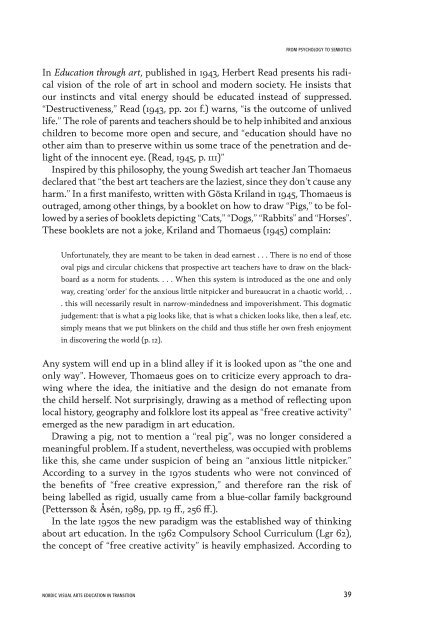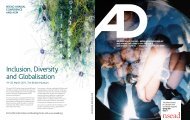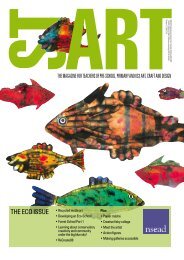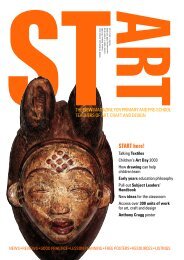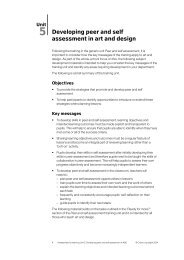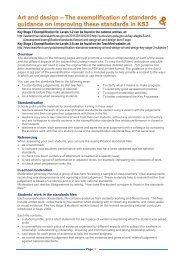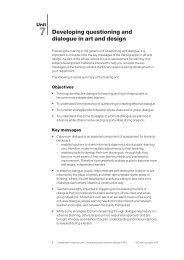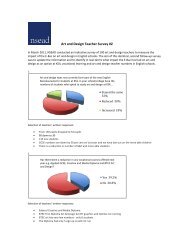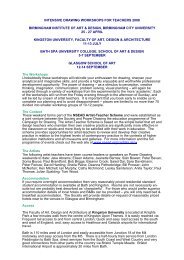Research in Visual Arts Education - Bilderlernen.at
Research in Visual Arts Education - Bilderlernen.at
Research in Visual Arts Education - Bilderlernen.at
You also want an ePaper? Increase the reach of your titles
YUMPU automatically turns print PDFs into web optimized ePapers that Google loves.
FROM PSYCHOLOGY TO SEMIOTICSIn <strong>Educ<strong>at</strong>ion</strong> through art, published <strong>in</strong> 1943, Herbert Read presents his radicalvision of the role of art <strong>in</strong> school and modern society. He <strong>in</strong>sists th<strong>at</strong>our <strong>in</strong>st<strong>in</strong>cts and vital energy should be educ<strong>at</strong>ed <strong>in</strong>stead of suppressed.“Destructiveness,” Read (1943, pp. 201 f.) warns, “is the out come of unlivedlife.” The role of parents and teach ers should be to help <strong>in</strong> hibited and anxiouschild ren to become more open and secure, and “educ<strong>at</strong>ion should have noother aim than to preserve with<strong>in</strong> us some trace of the penetr<strong>at</strong>ion and delightof the <strong>in</strong>nocent eye. (Read, 1945, p. 111)”Inspired by this philosophy, the young Swedish art teacher Jan Thomaeusdeclared th<strong>at</strong> “the best art teachers are the laziest, s<strong>in</strong>ce they don’t cause anyharm.” In a first mani festo, writ ten with Gösta Kriland <strong>in</strong> 1945, Thomaeus isoutraged, among other th<strong>in</strong>gs, by a booklet on how to draw “Pigs,” to be followedby a series of booklets depict<strong>in</strong>g “C<strong>at</strong>s,” “Dogs,” “Rabbits” and “Horses”.These booklets are not a joke, Kriland and Thomaeus (1945) compla<strong>in</strong>:Unfortun<strong>at</strong>ely, they are meant to be taken <strong>in</strong> dead earnest . . . There is no end of thoseoval pigs and cir cular chickens th<strong>at</strong> prospective art teachers have to draw on the blackboardas a norm for students. . . . When this system is <strong>in</strong>troduced as the one and onlyway, cre<strong>at</strong><strong>in</strong>g ‘or der’ for the anxious little nitpicker and bureaucr<strong>at</strong> <strong>in</strong> a chaotic world, . .. this will neces sarily result <strong>in</strong> narrow-m<strong>in</strong>dedness and impoverishment. This dogm<strong>at</strong>icjudgement: th<strong>at</strong> is wh<strong>at</strong> a pig looks like, th<strong>at</strong> is wh<strong>at</strong> a chicken looks like, then a leaf, etc.simply means th<strong>at</strong> we put bl<strong>in</strong>kers on the child and thus stifle her own fresh enjoyment<strong>in</strong> discover<strong>in</strong>g the world (p. 12).Any system will end up <strong>in</strong> a bl<strong>in</strong>d alley if it is looked upon as “the one andonly way”. However, Thomaeus goes on to criticize every approach to draw<strong>in</strong>gwhere the idea, the <strong>in</strong>iti<strong>at</strong>ive and the design do not eman<strong>at</strong>e fromthe child herself. Not surpris<strong>in</strong>gly, draw<strong>in</strong>g as a method of reflect<strong>in</strong>g uponlocal history, geography and folk lore lost its appeal as “free cre<strong>at</strong>ive activity”emerged as the new paradigm <strong>in</strong> art educ<strong>at</strong>ion.Draw<strong>in</strong>g a pig, not to mention a “real pig”, was no longer considered amean <strong>in</strong>gful problem. If a student, nevertheless, was occu pied with prob lemslike this, she came under suspicion of be<strong>in</strong>g an “anxious little nitpicker.”Accord <strong>in</strong>g to a survey <strong>in</strong> the 1970s students who were not conv<strong>in</strong>ced ofthe benefits of “free cre<strong>at</strong>ive expression,” and therefore ran the risk ofbe<strong>in</strong>g labelled as rigid, usually came from a blue-collar family background(Pettersson & Åsén, 1989, pp. 19 ff., 256 ff.).In the l<strong>at</strong>e 1950s the new paradigm was the established way of th<strong>in</strong>k<strong>in</strong>gabout art edu c<strong>at</strong>ion. In the 1962 Compulsory School Curriculum (Lgr 62),the concept of “free crea tive activity” is heavily emphasized. Accord<strong>in</strong>g toNORDIC VISUAL ARTS EDUCATION IN TRANSITION 39


